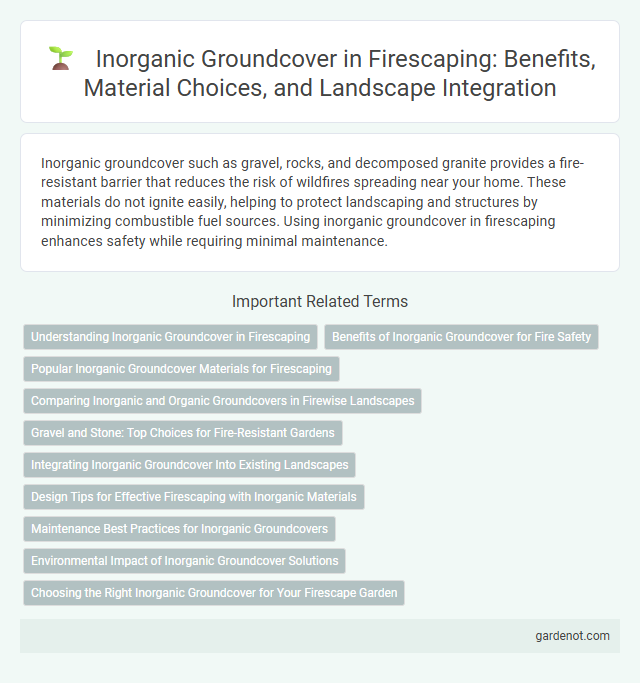Inorganic groundcover such as gravel, rocks, and decomposed granite provides a fire-resistant barrier that reduces the risk of wildfires spreading near your home. These materials do not ignite easily, helping to protect landscaping and structures by minimizing combustible fuel sources. Using inorganic groundcover in firescaping enhances safety while requiring minimal maintenance.
Understanding Inorganic Groundcover in Firescaping
Inorganic groundcover materials, such as gravel, decomposed granite, and crushed rock, play a critical role in firescaping by creating non-combustible zones that help reduce wildfire risks near structures. These materials effectively interrupt fuel continuity, minimizing the chances of fire spreading across landscapes. Proper installation and maintenance of inorganic groundcover ensure optimal fire resistance and contribute to a defensible space around homes in fire-prone areas.
Benefits of Inorganic Groundcover for Fire Safety
Inorganic groundcover, such as gravel, crushed rock, and decomposed granite, significantly reduces fire risk by creating non-combustible barriers that slow or stop the spread of flames. These materials help retain moisture in the soil, minimizing dry conditions that can fuel fires while requiring minimal maintenance compared to organic mulches. Incorporating inorganic groundcovers in defensible space areas enhances fire safety by limiting fuel availability and improving overall landscape resilience during wildfire events.
Popular Inorganic Groundcover Materials for Firescaping
Gravel, decomposed granite, and crushed stone are popular inorganic groundcover materials for firescaping due to their fire-resistant properties and excellent drainage capabilities. These materials create effective firebreaks by reducing combustible vegetation and minimizing fuel load around structures. Using inorganic groundcovers helps maintain defensible space while enhancing landscape aesthetics and durability.
Comparing Inorganic and Organic Groundcovers in Firewise Landscapes
Inorganic groundcovers such as gravel, stone, and decomposed granite offer superior fire resistance compared to organic materials like mulch or bark, reducing fuel availability in Firewise landscapes. These mineral-based groundcovers do not ignite or smolder, significantly lowering the risk of wildfire ignition near structures. Incorporating inorganic groundcovers in defensible space strategies enhances fire mitigation by creating effective fuel breaks and promoting safer property protection.
Gravel and Stone: Top Choices for Fire-Resistant Gardens
Gravel and stone are highly effective inorganic groundcovers that reduce fire risk by preventing the spread of flames and eliminating combustible materials near structures. Their non-flammable properties, combined with excellent drainage capabilities, make them ideal for fire-resistant landscapes. Popular options include pea gravel, decomposed granite, and crushed rock, which also contribute to low maintenance and long-lasting garden aesthetics.
Integrating Inorganic Groundcover Into Existing Landscapes
Inorganic groundcover such as gravel, decomposed granite, and lava rock enhances fire-resistant landscaping by creating effective firebreaks around structures and vegetation. Integrating these materials into existing landscapes reduces combustible plant material while maintaining aesthetic appeal and soil stability. Strategic placement around homes, pathways, and garden beds minimizes wildfire risk and complements drought-tolerant plantings for sustainable firescaping.
Design Tips for Effective Firescaping with Inorganic Materials
Inorganic groundcover options like gravel, decomposed granite, and lava rock provide fire-resistant surfaces that reduce fuel availability and help create defensible space around properties. Incorporating these materials in design plans involves layering with fire-resistant plants, maintaining proper spacing to prevent heat transfer, and ensuring good drainage to avoid debris accumulation. Using contrasting colors and textures enhances aesthetic appeal while maximizing fire safety in landscape design.
Maintenance Best Practices for Inorganic Groundcovers
Inorganic groundcovers like gravel, decomposed granite, and lava rock require minimal maintenance, primarily involving periodic debris removal to prevent fuel buildup near structures. Regularly raking and washing these materials helps maintain their appearance and fire-resistant properties by preventing plant growth and accumulation of combustible materials. Ensuring proper installation with weed barriers underneath significantly reduces maintenance efforts and enhances fire safety effectiveness.
Environmental Impact of Inorganic Groundcover Solutions
Inorganic groundcover solutions such as gravel, decomposed granite, and rubber mulch offer fire-resistant barriers that reduce wildfire risks by limiting combustible materials near structures. These materials have a lower environmental impact compared to organic mulches, as they do not contribute to soil nutrient depletion or release greenhouse gases through decomposition. However, the use of inorganic groundcovers can affect soil permeability and temperature regulation, potentially disrupting local microhabitats and soil microbial activity.
Choosing the Right Inorganic Groundcover for Your Firescape Garden
Selecting the ideal inorganic groundcover for your firescape garden involves prioritizing fire-resistant materials such as gravel, decomposed granite, or crushed stone, which effectively reduce flammable vegetation and inhibit fire spread. These materials not only enhance safety by creating defensible space but also require minimal maintenance and improve soil erosion control in fire-prone landscapes. Opt for groundcovers that complement your fire-safe landscaping plan by providing durability, heat resistance, and proper drainage to support overall garden resilience.
Inorganic groundcover Infographic

 gardenot.com
gardenot.com